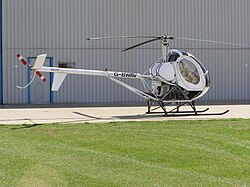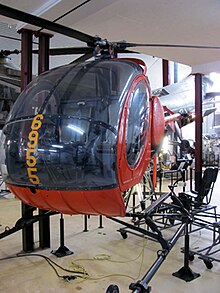Swiss 300C
| Swiss 300C | |
|---|---|

|
|
| Type: | Light helicopter |
| Design country: | |
| Manufacturer: |
Hughes Helicopters |
| First flight: |
March 6, 1969 |
| Production time: |
1970 - today |
| Number of pieces: |
3500 (all 269/300 models) |
The Swiss 300C (previously: Hughes 300C , also Hughes 269C ) is a light helicopter that is used in pilot training, for observation purposes, police tasks, agricultural operations and in recreational aviation. It is equipped with a piston engine.
Background of the development
The Swiss 300C is a further development of the Hughes Model 269 (designation of the military version: YHO-2HU and TH-55A ). The 300C (originally referred to as the Hughes 269C) was derived from the slightly enlarged Model 269B (sold as the Hughes 300), which was derived from the Model 269A; the main difference to its predecessors was the use of the more powerful Lycoming H1O-360 D1A engine with 190 hp and an enlarged main rotor diameter from 7.71 m to 8.14 m. The 300C made its maiden flight on March 6, 1969 and received FAA approval in May 1970.
After the production of 2,800 helicopters of all versions of the Model 269/300 / TH-55A series by Hughes Helicopters, license production was taken over by the Swiss Aircraft Corporation in July 1983 . Production in Elmira (New York) began in November 1983, the first machine built by Schweizer flew in June 1984. In 1986, the Schweizer company finally secured all rights to the 269 model series from McDonnell Douglas , which in 1984 bought the licensor Hughes . At that time the machine was briefly referred to as the Schweizer Hughes 300C , later only the Schweizer 300C .
In 2004 Schweizer was taken over by the Sikorsky Aircraft Corporation and has operated as a subsidiary of Sikorsky since then, the original company name (company) was retained. Since then, the helicopter has been marketed under the name Schweizer ™ S-300C ™ Helicopter by the civil aircraft division that has been operating as Sikorsky Global Helicopters since 2009 . The 300CBi variant is also part of the delivery program.
Despite this eventful history, both the basic construction and the visual appearance of the machine have changed only insignificantly in all these years. The license entry required in the German private pilot's license -H (the type rating ) for all models 269A, -B, -C as well as 300C, -CB and -CBi as well as the Breda Nardi 269 is still "Hu 269" .
construction
The 300C is built in the classic main / tail rotor configuration. The main rotor has three rotor blades and rotates to the left (counterclockwise) when viewed from above. The rotor head has a rigid center piece and flapping and swivel joints with elastomer dampers. The two-bladed tail rotor is mounted on the left side of the tail boom that is braced downwards and is driven by the main gearbox via a shaft. All control elements are mechanically linked directly, no hydraulic control aids are required.
The central part of the fuselage cell consists of a tubular framework, a closed, mostly glazed cockpit with two seats next to each other and a skid landing gear with shock absorbers. The air-cooled four-cylinder boxer engine Lycoming H1O-360 D1A, equipped with a cooling fan , is installed in a lying position, open behind the cockpit and under the main gearbox. The two fuel tanks are located on both sides above the engine and just behind the main rotor mast.
variants

Swiss 300CBi
The S-300CBi, introduced in 2002, is a variant tailored to the requirements of pilot training. By using the weaker Textron Lycoming HIO-360 G1A with manifold injection with 132 kW instead of the carburetor engine of the 300C, the susceptibility to carburetor icing has been eliminated, and a device for automatically engaging and ramping up the rotor is installed to protect against engine overspeed. This prevents operating errors and makes it easier to use in school. The dimensions are largely identical to the 300C, the flight performance and the payload are lower.
Firefly project
At the EAA AirVenture Oshkosh in July 2010, Sikorsky presented the Firefly project as a prototype. The helicopter, based on the Schweizer 300C, is equipped with a 190 HP electric motor , which draws its electrical energy from a lithium-ion accumulator with 300 cells that supply an electrical voltage of 370 volts . The helicopter was adapted by Eagle Aviation Technologies . However, to date (August 2015) there is no information that the first flight actually took place. It is only possible to fly with a pilot without additional passengers and with additional passengers, whereby the flight time should be around 5 to 10 minutes and the speed around 80 knots .
Technical specifications
| Parameter | Data S-300C |
|---|---|
| Seats | 1 pilot + 1 student pilot or 1 pilot + 2 passengers |
| Main rotor diameter | 8.18 m |
| Tail rotor diameter | 1.30 m |
| Main rotor speed | 471 / min |
| Overall length with the rotors running | 9.40 m |
| Hull length | 6.76 m |
| Track of the landing skids | 1.99 m |
| Top speed | 176 km / h |
| Cruising speed | 159 km / h |
| drive | a Textron Lycoming H1O-360 D1A with 190 PS (141 kW) starting and continuous output |
| Empty weight | 499 kg |
| Take-off weight ( MTOW ) | 930 kg |
| Payload | 431 kg |
| Tank capacity | Standard 120 l (32 US.liq.gal. ) |
| optional 240 l |
Similar types of helicopters
- Robinson R22
- Bell 47 (classic car, no longer in production)
- RotorWay Exec (Similar Size Kit Helicopter )
- Enstrom F-28
- Cabri G2
Web links
- The current S300C and S300CBi on the Sikorsky homepage
- Hughes TH-55A in the helicopter museum Bückeburg
Individual evidence
- ↑ www.aviastar.org: Model history of the 269/300 series , English
- ↑ List of type ratings for helicopters of the Luftfahrt-Bundesamt ( Memento from March 4, 2016 in the Internet Archive ), as of March 2009, PDF file
- ↑ www.b-domke.de: Representation of the rotor head
- ↑ Data sheet of the S-300CBi at Flugrevue (wayback-link) ( Memento from January 31, 2010 in the Internet Archive )
- ↑ www.sikorsky.com: Firefly ™ Technology Demonstrator (accessed on August 12, 2015)

